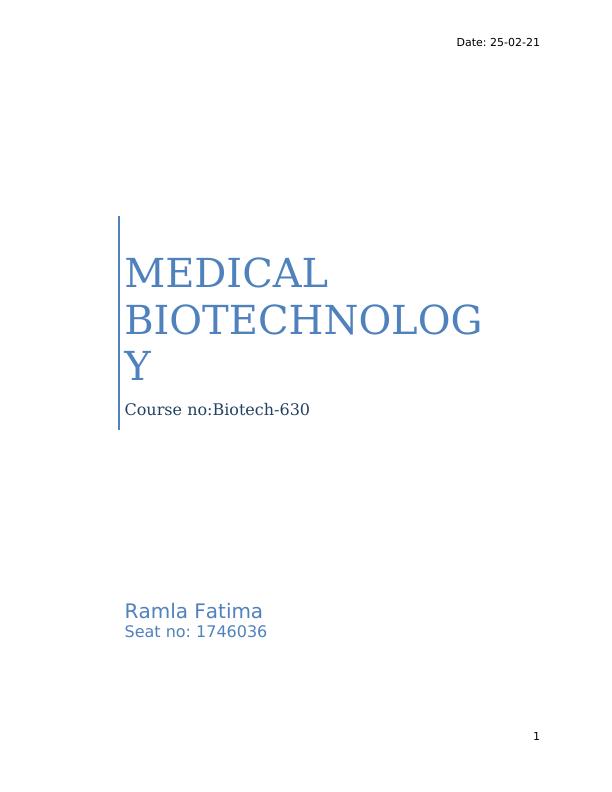Medical Biotechnology Assignment
Added on 2022-08-18
8 Pages2030 Words14 Views
Date: 25-02-21
1
MEDICAL
BIOTECHNOLOG
Y
Course no:Biotech-630
Ramla Fatima
Seat no: 1746036
1
MEDICAL
BIOTECHNOLOG
Y
Course no:Biotech-630
Ramla Fatima
Seat no: 1746036

Date: 25-02-21
Contents
DNA Polymorphisms................................................................................................... 2
Type of DNA polymorphisms...................................................................................... 2
i. Single nucleotide polymorphisms.....................................................................2
ii. Insertion/deletion polymorphisms.....................................................................2
iii. Polymorphic repetitive sequences....................................................................2
iv. Structural and copy number variations.............................................................3
DNA-based molecular markers................................................................................... 3
i. Single nucleotide polymorphisms.....................................................................3
ii. Microsatellites (short tandem repeats).............................................................3
Techniques for DNA-based molecular marker detection............................................4
i. Restriction fragment length polymorphism.......................................................4
ii. Polymerase chain reaction................................................................................4
iii. Genomic array technology................................................................................4
iv. Sequencing....................................................................................................... 4
Application for DNA-based genetic markers...............................................................5
i. Mapping human diseases and risk prediction...................................................5
ii. Quantitative trait loci mapping, candidate genes, and complex traits..............5
iii. Pharmacogenetics............................................................................................. 5
iv. DNA fingerprinting and human identification....................................................5
v. Sex-chromosome STR testing........................................................................... 5
vi. DNA typing and engraftment monitoring..........................................................5
REFERENCES.............................................................................................................. 6
2
Contents
DNA Polymorphisms................................................................................................... 2
Type of DNA polymorphisms...................................................................................... 2
i. Single nucleotide polymorphisms.....................................................................2
ii. Insertion/deletion polymorphisms.....................................................................2
iii. Polymorphic repetitive sequences....................................................................2
iv. Structural and copy number variations.............................................................3
DNA-based molecular markers................................................................................... 3
i. Single nucleotide polymorphisms.....................................................................3
ii. Microsatellites (short tandem repeats).............................................................3
Techniques for DNA-based molecular marker detection............................................4
i. Restriction fragment length polymorphism.......................................................4
ii. Polymerase chain reaction................................................................................4
iii. Genomic array technology................................................................................4
iv. Sequencing....................................................................................................... 4
Application for DNA-based genetic markers...............................................................5
i. Mapping human diseases and risk prediction...................................................5
ii. Quantitative trait loci mapping, candidate genes, and complex traits..............5
iii. Pharmacogenetics............................................................................................. 5
iv. DNA fingerprinting and human identification....................................................5
v. Sex-chromosome STR testing........................................................................... 5
vi. DNA typing and engraftment monitoring..........................................................5
REFERENCES.............................................................................................................. 6
2

Date: 25-02-21
DNA Polymorphisms
DNA polymorphisms are produced by changes in the nucleotide sequence or length. These result
from:
a. Variations in the fragment length pattern produced after digesting DNA with restriction
enzymes.
b. Variations in the size of a DNA fragment after PCR amplification.
c. Variations in the DNA sequence itself.
Since DNA from every tissue, from an individual show the same degree of polymorphism, they
become very useful identification tool in forensic applications. If an inheritable mutation is
observed in a population at high frequency, it is referred to as DNA polymorphism.
Type of DNA polymorphisms
i. Single nucleotide polymorphisms
Single nucleotide polymorphisms are the most common type of genetic variations in humans and
due to their abundance across the human genome; single nucleotide polymorphisms (SNPs) have
become important genetic markers for mapping human diseases, population genetics, and
evolutionary studies. SNPs are mostly formed when errors occur (substitution, insertion and
deletion) (Ismail & Essawi, 2012).
ii. Insertion/deletion polymorphisms
It is a type of DNA variation in which a specific nucleotide sequence of various lengths ranging
from one to several 100 base pairs is inserted or deleted. Indels are widely spread across the
genome. One base pair is considered as SNPs or repeat insertion/deletion as indels (Teama,
2018).
iii. Polymorphic repetitive sequences
DNA repeats can be classified as interspersed repeats or tandem repeats and can comprise over
two-thirds of the human genome.
Tandem repeats are organized in a head-to-tail orientation; based on the size of each repeat unit,
satellite repeats can be further divided into macrosatellites, minisatellites, and microsatellites.
Macrosatellites have sequence repeats longer than 100 bp and are the largest of the tandem DNA
repeats, located on one or multiple chromosomes. Minisatellites consists of stretches of DNA
and are characterized by moderate length patterns; 10–100 bp usually less than 50 bp.
Microsatellites are known as short tandem repeats (STRs) repeat units of less than 10 bp (Ismail
& Essawi, 2012).
3
DNA Polymorphisms
DNA polymorphisms are produced by changes in the nucleotide sequence or length. These result
from:
a. Variations in the fragment length pattern produced after digesting DNA with restriction
enzymes.
b. Variations in the size of a DNA fragment after PCR amplification.
c. Variations in the DNA sequence itself.
Since DNA from every tissue, from an individual show the same degree of polymorphism, they
become very useful identification tool in forensic applications. If an inheritable mutation is
observed in a population at high frequency, it is referred to as DNA polymorphism.
Type of DNA polymorphisms
i. Single nucleotide polymorphisms
Single nucleotide polymorphisms are the most common type of genetic variations in humans and
due to their abundance across the human genome; single nucleotide polymorphisms (SNPs) have
become important genetic markers for mapping human diseases, population genetics, and
evolutionary studies. SNPs are mostly formed when errors occur (substitution, insertion and
deletion) (Ismail & Essawi, 2012).
ii. Insertion/deletion polymorphisms
It is a type of DNA variation in which a specific nucleotide sequence of various lengths ranging
from one to several 100 base pairs is inserted or deleted. Indels are widely spread across the
genome. One base pair is considered as SNPs or repeat insertion/deletion as indels (Teama,
2018).
iii. Polymorphic repetitive sequences
DNA repeats can be classified as interspersed repeats or tandem repeats and can comprise over
two-thirds of the human genome.
Tandem repeats are organized in a head-to-tail orientation; based on the size of each repeat unit,
satellite repeats can be further divided into macrosatellites, minisatellites, and microsatellites.
Macrosatellites have sequence repeats longer than 100 bp and are the largest of the tandem DNA
repeats, located on one or multiple chromosomes. Minisatellites consists of stretches of DNA
and are characterized by moderate length patterns; 10–100 bp usually less than 50 bp.
Microsatellites are known as short tandem repeats (STRs) repeat units of less than 10 bp (Ismail
& Essawi, 2012).
3

End of preview
Want to access all the pages? Upload your documents or become a member.
Related Documents
Bacterial Forensics: PCR and Gel Electrophoresis Analysislg...
|7
|2229
|394
DNA Profiling in Parental Testing: Methods, Social Issues, and Historylg...
|2
|2466
|471
Biochemistrylg...
|8
|1465
|148
Methods and Techniques in Molecular Biologylg...
|10
|2412
|18
Role of Microarray Comparative Genomic Hybridizationlg...
|13
|3125
|69